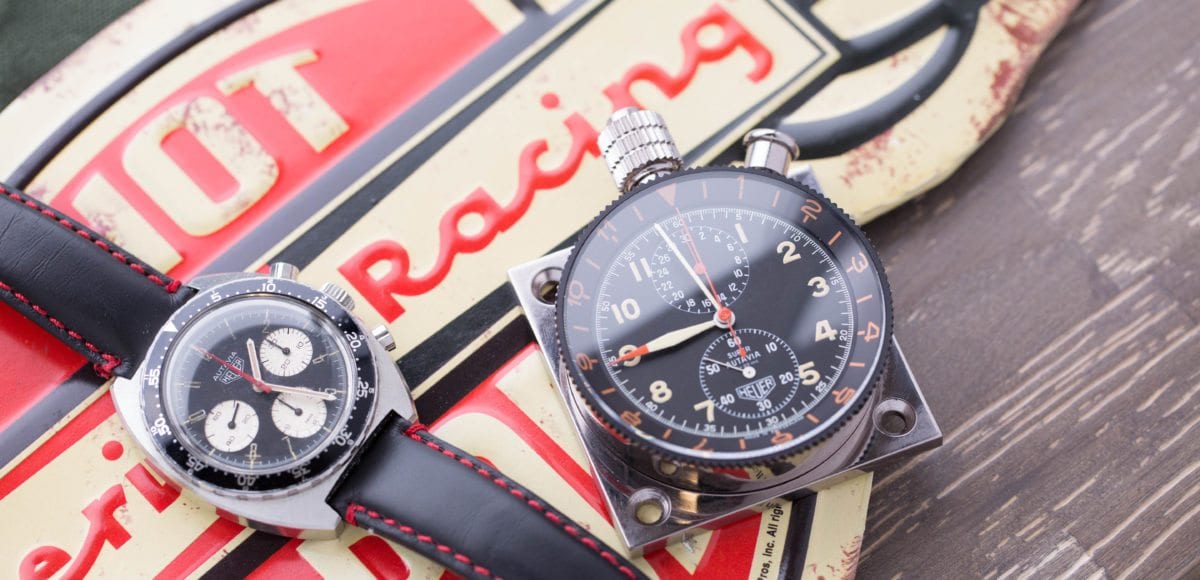Hear someone mention Heuer and you’ll likely think of the Monaco, Carrera, Autavia or any of Heuer’s other innovative chronographs. While Heuer is best known for its racing watches, the company originally made a name for itself with its dashboard timepieces.

A Heuer Super Autavia Dash Clock
Heuer’s dashboard timers were designed with the needs of automotive racers and aviators in mind. From the early 1930s until the mid-1980s, Heuer offered a range of mechanical automotive timers and clocks that have become highly collectible today.
From the Autavia (yes, it was a dash-mounted stopwatch before it became a wristwatch) to the Master Time or the Monte Carlo Sebring, join us as we look into the interesting history of Heuer auto, aircraft, and marine dashboard clocks and timers.
1933: Heuer Introduces its First Dashboard Timepieces
Heuer introduced its first dashboard timer in 1933. The Autavia–named for “automotives” and “aviation,” its two uses–was a dual-register chronograph, with hours recorded on the lower of the two registers, minutes on the top, and seconds by the center hand.
The first Autavia chronograph used a Valjoux 59 movement. Over time, Heuer phased out the Valjoux 59, replacing it with a Valjoux 340 for later versions of the Autavia. The newer version has its pusher to the right of the crown, while the older model has a left-side pusher.

Two early Autavia dash clock models.
If the Autavia name sounds familiar, it should. Heuer manufactured the Autavia dashboard timer from 1933 until 1958, when it discontinued the model and replaced it with the Monte Carlo. Just four years later, it revived the Autavia name for its iconic chronograph wristwatch.
Alongside the 1933 Autavia, Heuer released a pair of timers called the “Hervue” pair. The pair of timers included a time-of-day clock called the Hervue Junior mounted on the same backplate as a 12-hour Autavia timer.
1950s: New Models, New Names and New Designs
Heuer changed their lineup of dash-mounted timepieces in the 1950s. A 60-minute stopwatch called the Auto Rallye was introduced in the mid-1950s. In 1958, the Hervue was renamed the Master Time and the Monte Carlo replaced the Autavia.
In the late 1950s, after Heuer discontinued the Autavia, the pair of timers became known as the Rally-Master, with the Autavia side of the pair dropped in favor of a 12-hour Monte Carlo timer, and the Hervue Junior redesigned and renamed as the Master-Time.

Two Auto Rallye timers side by side.
That same year, Heuer also introduced an innovative new dashboard chronograph called the Super Autavia. Designed for cars, airplanes, and boats, the Super Autavia featured a rotating bezel which allowed it to record Time of Day and Time of Trip simultaneously.
Fans of the Heuer Autavia wristwatch will notice some of that watch’s design characteristics in the early Super Autavia. Heuer released the Autavia wristwatch four years later in 1962 as the first of three new chronographs introduced over the decade.
1960: The Sebring Split-Second Timer
In 1960, Heuer released the Sebring, an innovative split-second timer capable of displaying time down to the hundreds of seconds. The first Sebring used an A. Schild 1564R movement; the second–introduced in 1967 with an updated design–used a Valjoux 7711 movement.

A comparison of two Heuer Sebring dials.
Heuer also introduced several other dashboard timepieces at the time specifically for use on aircraft. The Aircraft Chronograph, Clock, and IFR were all designed for commercial and private aircraft, while the Navia–a waterproof 8-day clock–was built to be mounted as part of the control panel of a boat.
Heuer continued to produce many dashboard timepieces until it was acquired by TAG in 1985. Today, many Heuer dash-mounted timepieces are valuable collector pieces, commanding considerable values among collectors and racing timepiece enthusiasts.
Images ©: Header, 1; Crown & Caliber. 2-4; OnTheDash.
Get More Articles Like This in Your Inbox
We're constantly creating great content like this. So, why not get it delivered directly to your inbox? By subscribing you agree to our Privacy Policy but you can unsubscribe at any time.






